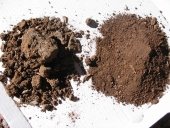posted 14 years ago
I'm thinking that yukkuri kame's suggestion is most workable. Soil doesn't hold nutrients here. The canopy does...living plants do...large slow decaying things do.
Hanley's idea sounds like the method I've seen used in an organic farm around here. It'll grow a garden for you all right, but you've got to remake the raised beds from scratch every year, too.
Bentonite clay, if my information is correct, is a key ingredient in kitty litter -- especially the clumping type. When my kitty died last year I put the remainder of her litter out on the grass to see what would happen. I see little or no sign of any of it in that area any more. It has almost all washed through. The plants I hoped to encourage, didn't have any growth spurt either. That was the regular clay kitty litter, so not a fair test of Bentonite clay really. That is a possibility to try someday. (I won't believe it until I see it that it will stay any place that I put it for very long.)
I have also been trying the terra preta idea. I have been wondering if maybe the right approach is to skip the turn it into a powder stage, and just add the charcoal to areas still in twig form -- and thus reduce the washing it away effect.
I also have a hugelkultur pit experiment going. I expect that it will be a major termite attractor (termites love decaying wet wood out of the sunlight), and that the wood will be gone from there in less than a year, but I am holding out hope that I will be proven wrong about that.
Another approach to hugelkultur I am trying (and which I have more hope for), is just adding the branches on top of the soil. Do this a little at a time, like what happens in a forest during a wind storm. These branches decay slowly, and therefore release their nutrients slowly. They increase the availability of moisture to plants growing near them. In that area I already have a perennial legume growing, so I think I have a nitrogen source there...
You know, I just had a light bulb go on, the other item that contributes slow release fertility around here is sweet potato. Some of them grow as perennials in Florida. I think that would be an apt addition and be a source of a whole different set of nutrients for plants in that area.
Thanks everyone for your help, (and I won't object to more, if you want to give it).

















 -Art Donnelly
-Art Donnelly 1
1
























